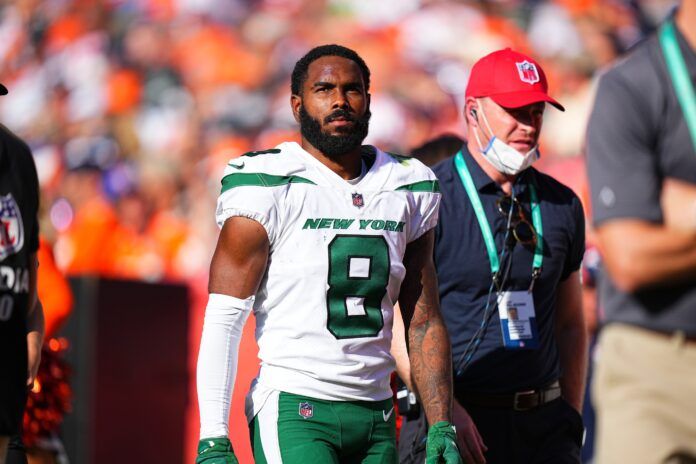The Los Angeles Chargers offense has struggled a bit since losing Keenan Allen in Week 1. While they’ve avoided disastrous dips in production, they’re hovering around average, which won’t get the job done in the AFC West.
There is an elephant in the receiving corps. There’s no speed. That’s why Tom Telesco needs to get on the phone with Joe Douglas regarding New York Jets WR Elijah Moore.
The Chargers’ offense was successful in spite of itself in 2021. Los Angeles finished fifth in EPA per play despite seeing all of media criticize the passing attack’s architecture. The NFL has a sample size issue in a full season, let alone a third of the way through.
However, a third of the way through the season, the Chargers rank 14th in EPA per play, 14th in drive success rate, and 12th in DVOA. Losing Rashawn Slater and Allen together is a lot to overcome, but it’s excruciating to watch their receivers on Sunday struggle to separate.
Justin Herbert Deserves Elijah Moore
Of the 32 quarterbacks in the NFL with over 500 plays in the past two seasons, only Ben Roethlisberger, Daniel Jones, and Matt Ryan have averaged fewer air yards than Justin Herbert.
That’s the equivalent of using a Ferrari 488 only to go to the grocery store down the street, where the speed limit only ever hits 35 MPH. The argument here would be that Patrick Mahomes ranks 27th of 32, but that argument falls flat.
Johnny Kinsley puts together an outstanding Deep Ball Project every season. In 2021, Mahomes attempted 67 passes past 21 yards downfield. Josh Allen attempted 63. Herbert sat at 46. Even Kirk Cousins attempted more downfield passes last season.
And things are much worse this season. Herbert’s aDOT has gone from 7.6 in 2021 to 6.3 so far through six games in 2022. While Mahomes’ attempts closer to the line of scrimmage often sees him find receivers running free, the Chargers are conceptually stale, which makes them easy to defend.
That forces Herbert to be as close to perfect as possible. He’s forced into perfectly leveraging passes away from defenders draping his target. Mike Williams is catching 60% of his targets, but so many of them are on low-percentage throws against tight coverage. Herbert’s only real reprieve comes when targeting Austin Ekeler, who has just one fewer target than Williams.
Elijah Moore vs. the Chargers Receivers
Moore ran a 4.35 at the NFL Combine and posted elite agility numbers to boot. The rest of the Chargers’ receivers look like this:
Keenan Allen: 4.71 (We know he’s faster than that, but he’s not Tyreek Hill.)
Mike Williams: 4.57
Joshua Palmer: 4.51
DeAndre Carter: 4.44
Carter isn’t slow, but he doesn’t necessarily threaten defenses either way. There’s a reason he’s played on five different teams in his five NFL seasons. As a depth piece playing a few snaps a game, Carter doesn’t hurt to have, but counting on him as a starter is a terrifying proposition.
None of the Chargers’ receivers are as dynamic as Moore. The pocket-sized receiver is tough as nails, too. He only carried the ball 14 times at Ole Miss in 2020, but he did so out of the backfield during a game, which was a great display of his vision and balance as a runner.
Moore Gives the Chargers Options
Austin Ekeler is also dynamic as a receiver, but adding Moore helps give Joe Lombardi options at the line of scrimmage, along with being a downfield threat given his speed. Much of Moore’s usage in New York has been in the RPO game, going in motion and getting the ball in bubble looks or flat routes, where he can be creative after the catch.
Additionally, Moore stacks defensive backs well when used as a vertical threat. He’s shifty upon release and much more physical than his frame would suggest, which helps him get over the top of defensive backs.
MORE: Ranking the Best NFL Acquisitions of 2022
Even when used as a decoy to influence a safety, Moore brings value because his athleticism forces safeties to respect him, which opens up the intermediate in-breaking throws to Allen and Mike Williams.
But he also provides a better option on crossing routes, which Los Angeles uses plenty of, especially in their under-center play-action game. His speed stresses man coverage in those spots.
Is There a Catch?
Yes.
Moore is like many young receivers who are smaller in stature, endlessly shifty, and as fast as a stabbed rat. He’s an imprecise route runner. There are times where — from the outside looking in — Moore might be a bit lazy.
Zach Wilson’s downfield interception on the left side of the field against Pittsburgh may have been Moore’s fault. The “route” Moore ran was vertical for about 12 yards, and then he sort of stopped, but he didn’t actually run a curl or comeback. And with Pittsburgh’s middle-of-field-closed look, Moore was probably supposed to run his cornerback to the back of the end zone.
Instead, he lazily stopped, and his defender sank back into the zone the deep crosser entered, leading to the interception.
Even in isolated situations, Moore doesn’t do a great job selling something else because experienced cornerbacks aren’t buying it. However, anybody who follows the Chargers’ offense knows Lombardi loves him a Stick concept.
On routes in the vertical plane and less-complex routes, Moore’s natural quickness is a weapon. So although he has a ways to go as a professional route runner, that does not mean he consistently struggles to separate.
His natural quickness helps most on routes stopping and coming back to the football, like curls and comebacks, which are widely used in the Chargers’ passing attack.

